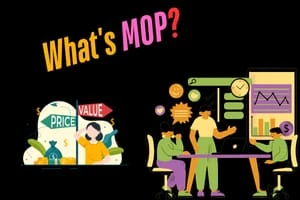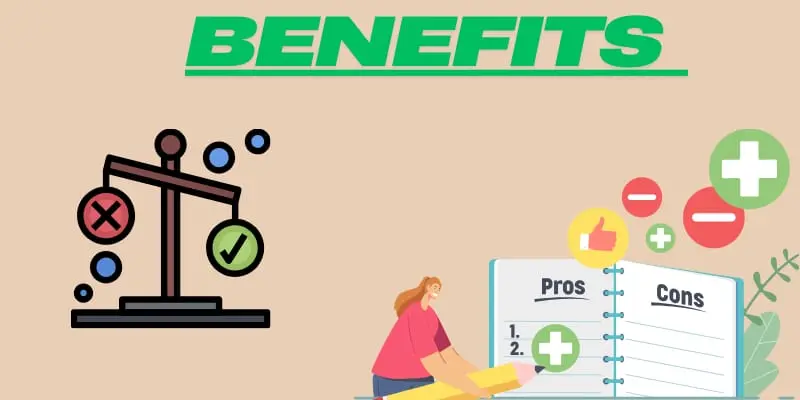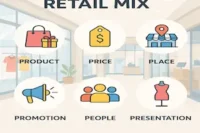What Is MOP In Retail and Sales? MOP & SRP Explained.
Published: 25 Feb 2025
Guys, when you buy something, you will most likely notice the same product has different price tags from city to city and market to market.
But guys, have you ever thought about why this happens? No? Let me tell you—this is where the Market Operating Price (MOP) comes into play.
Market Operating Price (MOP) is the final price of a product to sell, and it’s decided after considering a lot of factors, including:
- Product manufacturing and labor costs
- Taxes
- Profits for businesses
- And many others like competition and customer demand.
Understanding MOP is the most important for all, including
- Manufacturers or brand owners
- Retailers
- And even consumers
So keep reading here I shared a detailed guide on what MOP, what SRP is, how they are calculated, and why they are important.
So let’s start the journey!
What is MOP in Retail and Sales? Meanings and Definitions.

Alright, now let’s get into it in detail.
Market Operating Price (MOP)—is the final price of goods that we pay for in retail stores.
As previously shared, it’s not just a random number but calculated carefully by considering multiple factors so the business makes sure they still secure handsome profits.
Here is how MOP is calculated.
- Product Costs: This includes the cost of materials, labor, and manufacturing. For example, if a pair of shoes cost $20 to make, that’s the starting point.
- Operating Expenses: Next, businesses add costs like transportation, storage, and marketing. Let’s say that adds another $5.
- Taxes and Fees: Governments often add taxes, which might be another $3.
- Profit Margin: Finally, businesses add a little extra to make a profit. If they add $12, the final MOP becomes $40.
But remember one point—MOP isn’t the same everywhere. It changes based on:
- Location: Prices might be higher in big cities because of higher taxes or operating costs.
- Competition: If a store wants to stay ahead of its rivals, it might lower its MOP.
- Demand: If a product is super popular, the MOP might go up.
Most of the time, market operating price (MOP) is fixed by brands or manufacturers by considering supply and demand.
Well-known brands say you can resell our products with a minimum of this price range, less is not allowed.
MOP is also not printed.
The printed prices that we see are MRP (Maximum Retail Price) which are also set by manufacturers or brand owners at which a retailer can legally sell their goods.
In case of any violation, the retailer can face legal consequences like a pause in shipping, fines, or other penalties.
Why Is MOP Important?

- MOP ensures businesses cover all production and operational costs, including materials, labor, and transportation.
- It helps manufacturers and retailers maintain healthy profit margins while staying competitive in the market.
- MOP provides a clear pricing structure, making it easier for retailers to set selling prices.
- It prevents undercharging or overcharging, ensuring fair value for both businesses and customers.
- It builds trust with customers by offering transparent and consistent pricing.
- MOP allows businesses to adapt to market changes, such as shifts in demand or competitor pricing.
- It supports long-term business growth by ensuring financial sustainability and customer satisfaction.
What is SRP? Meaning and How It’s Determined.
- SRP stands for Suggested Retail Price.
It is the price recommended by manufacturers for retailers to sell their products to end customers.
It’s not a fixed rule but rather a guideline to help maintain consistency and fairness in pricing across different markets and stores.
SRP is also determined by considering multiple factors including:
- Production Costs: This includes the cost of materials, labor, and manufacturing. For example, if a product costs $20 to make, this is the starting point.
- Marketing and Advertising: The expenses spent on promoting the product to potential customers are factored in.
- Distribution and Logistics: Costs like transportation, storage, and delivery to retailers are also added.
- Competitor Pricing: Manufacturers analyze what similar products are selling for in the market so they set Suggested Retail Price (SRP) accordingly to stay competitive.
- Target Market: The price is tailored to suit the purchasing power and preferences of the intended audience.
For instance, if a manufacturer suggests an SRP of $50 for a backpack, retailers might sell it at that price or adjust it slightly based on local demand or promotions.
Why Is SRP Important?
- SRP ensures pricing consistency across different retailers and markets, creating a fair and level playing field.
- It helps manufacturers maintain control over their brand’s pricing image and reputation.
- SRP provides retailers with a clear guideline for setting selling prices, reducing confusion or guesswork.
- It gives customers a reference point to understand the product’s value and compare prices across stores.
- It supports transparency in pricing and building trust between manufacturers, retailers, and consumers.
- SRP helps businesses tailor prices to suit the purchasing power and preferences of their target audience.
- It ensures that all parties in the supply chain, including manufacturers, wholesalers, and retailers, earn their expected profits.
Hey! My Dears.
So in this article, we’ve taken a closer look at what MOP and SRP are, how they’re determined, and why they matter in the world of retail.
MOP (Market Operating Price) ensures businesses cover costs and earn profits, while SRP (Suggested Retail Price) helps maintain pricing consistency and fairness across markets.
Together, they create a balanced pricing strategy that benefits manufacturers, retailers, and consumers alike.
Whether you’re running a business or simply shopping, understanding MOP and SRP can help you make smarter decisions and get the best value for your money.
So, the next time you see a price tag, you’ll know there’s more to it than meets the eye!
More Queries?
Some questions related to MOP and SRP that people often ask.
MOP stands for Market Operating Price. It’s the final price at which a product is sold, covering production costs, taxes, and profit margins. It ensures businesses stay profitable while offering fair value to customers
SRP stands for Suggested Retail Price. It’s the price recommended by manufacturers for retailers to sell products to customers, ensuring consistency across markets.
MOP is calculated by adding production costs, operating expenses, taxes, and a profit margin. For example, if a product costs $10 to make, $2 for expenses, and $3 for profit, the MOP becomes $15.
SRP is determined by considering production costs, marketing expenses, competitor pricing, and target market preferences. Manufacturers suggest this price to maintain brand value and fairness.
Yes, retailers can adjust the SRP based on competition, location, or promotions. However, sticking to the SRP helps maintain pricing consistency and brand trust.
MOP ensures businesses cover costs and earn profits while staying competitive. It also helps manage inventory and build customer trust through fair pricing.
SRP gives customers a clear idea of a product’s value and helps them compare prices across stores. It ensures transparency and prevents overcharging.
Selling above SRP can harm customer trust and lead to complaints. In some cases, it may violate pricing guidelines, resulting in legal consequences or fines.
MOP is the price retailers pay to buy products, while SRP is the price they’re suggested to sell them for. Together, they create a balanced pricing strategy that benefits manufacturers, retailers, and customers.
MOP means the price a retailer pays to buy a product from a manufacturer. It includes all costs involved in making and delivering the product, plus a profit for the manufacturer.

- Be Respectful
- Stay Relevant
- Stay Positive
- True Feedback
- Encourage Discussion
- Avoid Spamming
- No Fake News
- Don't Copy-Paste
- No Personal Attacks



- Be Respectful
- Stay Relevant
- Stay Positive
- True Feedback
- Encourage Discussion
- Avoid Spamming
- No Fake News
- Don't Copy-Paste
- No Personal Attacks




